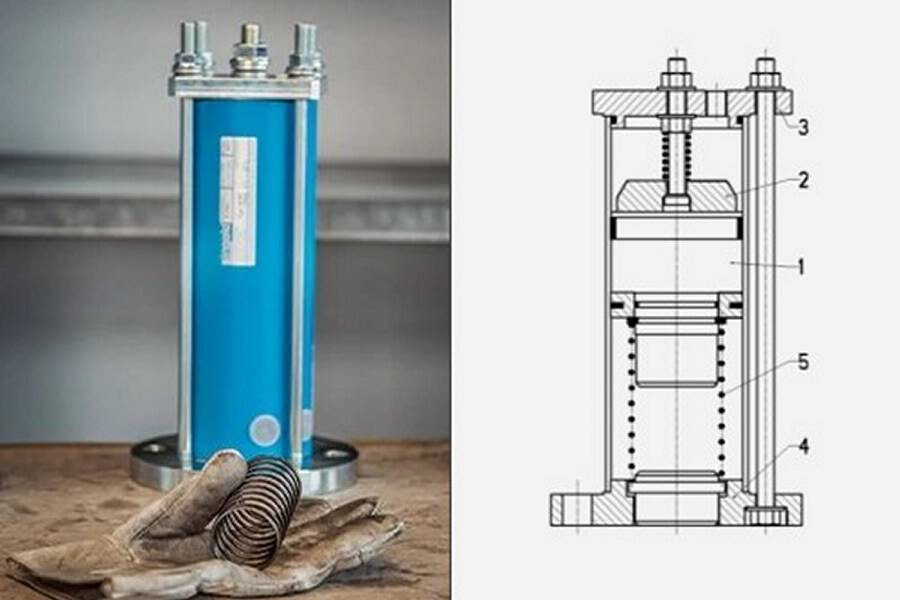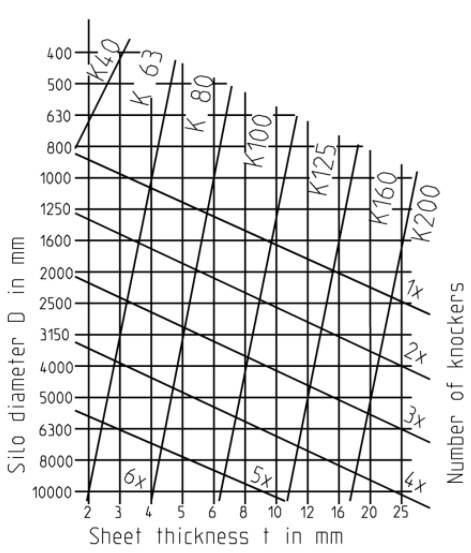APPLICATION
The Pneumatic Knocker is used for bulk goods with flow problems, such as bridging, funnel flow and stagnant zones, when high speed shakers and vibrators with soft sine-shaped oscillations are no longer effective.
Better than a hammer
The effect of the knocker is comparable to the infamous "silo hammer", but without the damage a hammer can do. Dents by hammers wil complicate the material flow even more. And cracks and ruptures can also occur.
The effectiveness of the knocker is evaluated according to the following rule: If the product can be knocked off or made to flow with a hand hammer, the Pneumatic Knocker is also effective.
Mounting of the knocker
The knocker is normally controlled by an electrical control system with a solenoid valve. Within the area where the knocking takes place there should be enough space for the impact to expand in all directions.
Reinforcements of the silo walls and additional ribs should be avoided, as this increases the weight and the strength of the silo walls and thus reduces the effect of the knocker.
Impact energy and impulse
The Pneumatic Knocker produces an ideal elastic shock that is specified as the impact energy: E = m/2 * v^2 [kgm/s2 = Nm] and as impulse: J = m * v [kgm/s = Ns]. There is no impact force or out-of-balance such as vibrators generate.
[IMG02**M60**Style]
CONSTRUCTION & FUNCTIONING
[IMG01**L42**Style]The air hammer achieves a very high impact energy through the stored and immediately released compressed air energy.
The left picture shows the construction of the knocker: The piston (1) designed as a permanent magnet, adheres in the end-position to the anchor plate (2) until the compressed air fed through the lid (3) overcomes the magnetic force.
The impact piston (1) loosens from the anchor plate (2), is very highly accelerated by the accumulated compressed air and hits onto the striker (4) with a speed of 6 to 7 m/sec., which transmits the impact to the silo wall.
After deaeration of the knocker, the impact piston (1) is pressed back into the starting position by means of the spring (5).
SIZES & SELECTION CHART
[IMG03**R50**Style]The singold Selection Chart provides a rough reference for selecting the adequate size and number of Pneumatic Knockers for round silos of 60° cone. In case of rectangular containers, a minimum of two knockers are mounted on the less steep sides.
Important parameters for the selection of the right knocker:
Mechanical aspects
- Thickness of the container
- Container material
- Container diameter
- Operating temperature
- If present, insulation thickness for the selection of the mounting
- Choice of version in aluminium, steel or stainless steel
- Protection type for operating environment
For the electrical components:
- Desired operating voltage
- Number of knockers
- Protection type for operating environment
MOUNTING & OPERATION
For the assembly and operation of the pneumatic knocker the components shown in the figure below are required:
[IMG04**M80**Style]
- Attaching the Pneumatic Knocker Welding plate AP. With small pipes, small containers or containers with insulation welded plate in T-shaped APT
- Pneumatic 3/2 way solenoid valve in the desired control voltage.
- Electrical control for solenoid valve to desired control voltage. An existing PLC control can also be used.
- Pneumatic connectors and cables
- Maintenance unit for pressure reduction to 3.5 bar operating pressure, drainage and lubrication of the knocker is recommended.







